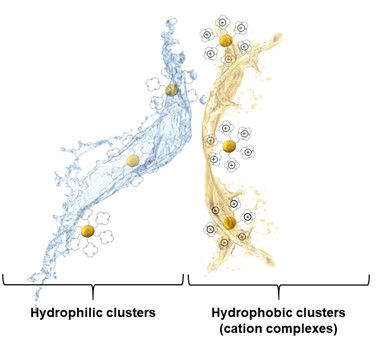Amphiphilic markers for bio-imaging: gold nanoclusters and amyloids under TEM and fluorescence examination.
- Abstract number
- 35
- Presentation Form
- Poster
- Corresponding Email
- [email protected]
- Session
- Poster Session 1
- Authors
- Patryk Obstarczyk (1), Anna Pniakowska (1), Marcin Grzelczak (1), Joanna Olesiak-Banska (1)
- Affiliations
-
1. Advanced Materials Engineering and Modelling Group, Wroclaw University of Science and Technology, Wybrzeże Wyspiańskiego 27, 50-370 Wroclaw, Poland
- Keywords
Amyloids, peptides, proteins, nanoclusters, hydrophobicity, hydrophilicity, amphiphilic, probes, bio-imaging, TEM, spectroscopy
- Abstract text
Graphical abstract: Cartoon of crown-ether capped gold nanoclusters phase transfer due to the cation complexation
Noble metal nanoclusters (NCs), being a contractual bridge between single metal atoms and broadly studied bulk materials, exhibit extraordinary optical properties, significantly influenced by the type of metallic core atoms or protecting ligands [1]. Their molecule-like behavior, potential functionality and small size alongside the versatile control over their chemical formation are attracting an ever-growing attention in terms of modern bio-imaging. Herein, we present novel luminescent material, crown-ether capped gold nanoclusters, whose feature is the amphiphilicity governed by complexation of ligands. The main purpose of designing small nanoclusters stabilized with supramolecular ligands is to take advantage of host-guest functionality for efficient modulation of gold nanostructures hydrophobicity to sufficiently and selectively stain various biological systems. We applied these nanoclusters for amyloid formation studies. We present the concept of cation complexation by gold NCs capped with thiolate crown ether, leading to gradual change of clusters hydrophilicity to hydrophobicity, which determinate the interactions with protein aggregates [2,3,4]. Amyloid fibrils are associated with neurodegenerative diseases (e.g. Alzheimer’s disease) and characterized by unique structure with distinctive cross-β-sheet conformation, where hydrophobic and hydrophilic parts of amyloidogenic protein are distinctly folded [5]. As expected, our NCs were binding to amyloid fibrils, which was observed under TEM imaging. Moreover, crown-ether capped NCs present luminescence with distinct band located in near infra-red wavelengths. Our NCs can be applied as functional cation-sensitive markers for one- and two-photon microscopy. Therefore, we present a new type of amphiphilic nanomaterials which tailored spectral properties for various applications in bio-imaging of hydrophobic and hydrophilic interfaces.
- References
[1] Olesiak-Bańska, J.; Waszkielewicz, M.; Obstarczyk, P.; Samoć, M. Two-Photon Absorption and Photoluminescence of Colloidal Gold Nanoparticles and Nanoclusters, Chem. Soc. Rev., 2019,48, 4087-4117
[2] Grzelczak, M. P.; Hill, A. P.; Belic, D.; Bradley, D. F.; Kunstmann-Olsen, C.; Brust, M. Design of Artificial Membrane Transporters from Gold Nanoparticles with Controllable Hydrophobicity. Faraday Discuss. 2016, 191, 495–510
[3] Wasada, H.; Tsutsui, Y.; Yamabe, S. Ab Initio Study of Proton Affinities of Three Crown Ethers. Journal of Physical Chemistry 1996, 100, 7367–7371
[4] Tian Y, Zhang X, Li Y, Shoup TM, Teng X, Elmaleh DR, Moore A, Ran C. Crown ethers attenuate aggregation of amyloid beta of Alzheimer's disease. Chem. Commun., 2014,50, 15792-15795
[5] Iadanza, M.G., Jackson, M.P., Hewitt, E.W. et al. A new era for understanding amyloid structures and disease. Nat Rev Mol Cell Biol, 2018, 19, 755–773

